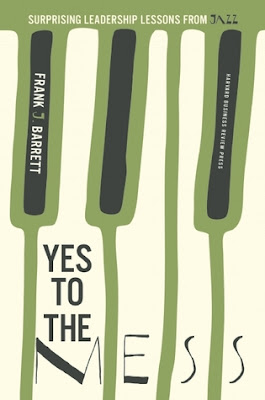When I first read Yes to the Mess, I was struck by the similarities in thought and process that my work in fire had with jazz. At first glance, it's easy to miss these similarities, especially since jazz is kind of a niche art form. I know I'm not much of a jazz fan, and I don't know too many people that are, at least in my fire circle of friends and coworkers.
Think about it: Just about everything we do in fire operations is improvisation. When the tone goes off and an engine crew responds to a fire, there may be a framework of general operating procedures laid out, but once on scene it's up to the IC and firefighters to assess the situation, and respond as needed. There's no step-by-step guide for what to do in every situation, so we improvise. Maybe the terrain keeps us from attacking one section of the fire with the engine, so we adapt by laying hose and going on foot. In helitack, we're improvising from the moment we start to size up the fire, deciding where to land, how to hike to the fire, what actions to take when we get there. We improvise all the time in fire.
Another similarity is that we typically work in small teams, just like small jazz bands. The give and take between members of the "team" in pursuit of that common goal is a theme throughout the book. On a fire crew, we all fill different roles at different times. Sometimes I'm the leader, sometimes I'm not. Sometimes I'm the expert, sometimes I'm not. How I react and perform in those different roles, and how I let the "lead" flow from one person to another, depending on the situation, is an important part of small team leadership. There are a few points in the book where the author discusses how this healthy back and forth is good for teamwork.
One thing that really stood out to me is the idea that, for the most part, jazz is forgiving of errors and mistakes, and finds ways to incorporate those mistakes into positive outcomes. In particular, I really loved the idea that "Jazz musicians assume that you can take any bad situation and make it into a good situation." I love that attitude, and let's be honest, that's an attitude shared by many firefighters even if we don't formally recognize it. We have that cultural "can do" attitude that really is all about doing what we can with what we have, making positive outcomes from bad situations. It can even be argued that really, that's our job—taking bad situations and turning them into good situations. Yes to the Mess talks a lot about how people interact with each other, analyzing "bad" situations and improvising to make it a "good" situation.
What I really appreciated after reading Yes to the Mess is that it contains a lot of ideas on how to be not just a better leader, but a better follower and a better team player. I really liked the ideas about taking turns sharing the "lead" and following, regardless of role in the organization. Jazz may not share a lot of similarities with firefighting in the physical sense, but when it comes to behavior, what works for jazz can work for us as well. Take few minutes, hours, or days to read through it, and give it some thought. I found a lot of good ideas about being a follower and leader in my organization, and hopefully you will too. Leaders are Readers!
Until next time...
For more information on the WFLDP and the Professional Reading Program, check out the website and the tools available there.
************************************************************
Justin Vernon is a regular guest contributor on our blog. Justin works for the United States Forest Service and is a member of the NWCG Leadership Subcommittee as the steward of the Professional Reading Program. Check out his Chasing Fire blog. All expressions are those of the author.

No comments:
Post a Comment